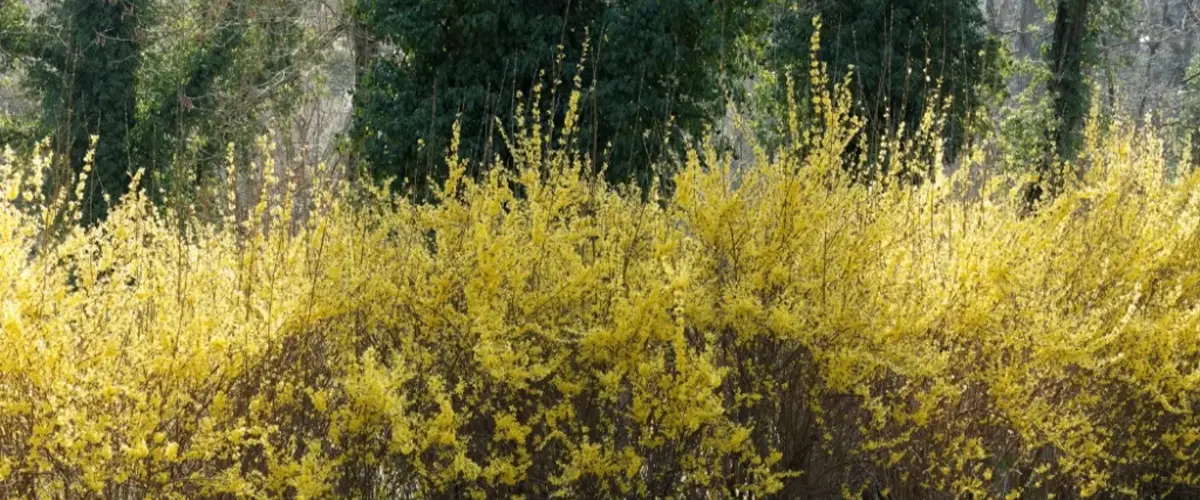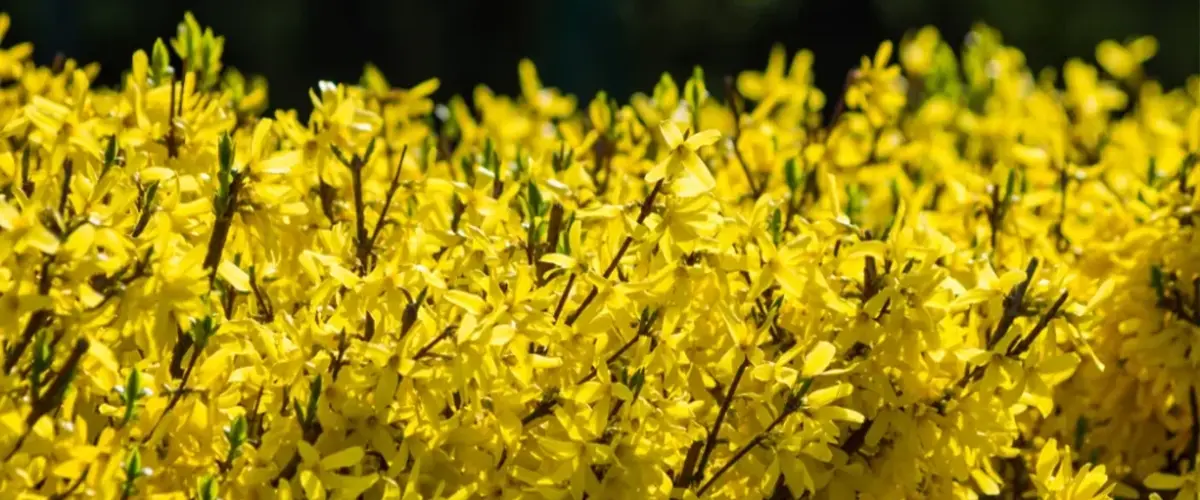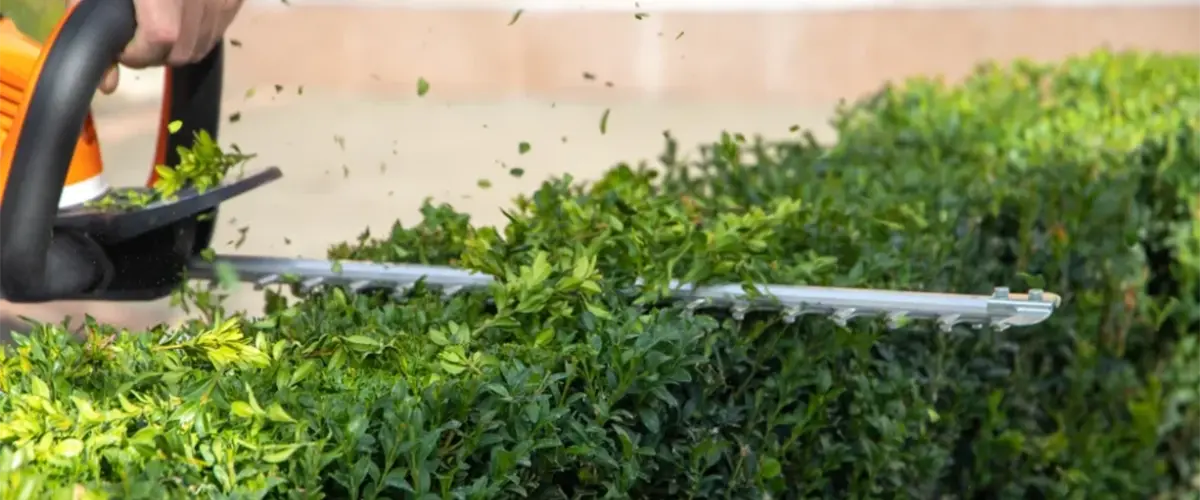
Are you looking for the perfect way to liven up your property’s edges and boundaries? Or are you trying to create a boundary, enhance the aesthetic, or get more privacy for your property?
In this article, we’ll explore some key differences between forsythia and boxwood, two of the most popular hedge plants. By the end of this post, you’ll have a better idea as to which green foliage (or both) is best for your home.
Forsythia Vs. Boxwood
Plant Type
Forsythia bushes are deciduous shrubs that often produce yellow flowers in early spring. They are known to bloom reliably every year and require little maintenance beyond pruning once annually.
Boxwoods, on the other hand, are evergreen shrubs that come in a variety of shapes—including pyramidal, spreading, globe-shaped, and columnar—depending on the variety you choose. They tend to require more maintenance than forsythias, but both are still low-maintenance shrubs. You’ll want to get the benefits from yearly pruning, plus you can shear them into various shapes if desired.
Size

Forsythias range in size from 2 to 10 feet tall and wide, making them ideal for creating privacy fences or as standalone decorative elements in your yard.
Most boxwoods range in size from 2 to 8 feet tall and wide, though some varieties may reach up to 10 feet tall with time.
The size of each plant varies depending on the variety you choose, but generally speaking, forsythias grow larger than boxwoods when they mature.
Best USDA Hardiness Zones
Forsythias tend to tolerate colder temperatures better than boxwoods do (down to USDA Zones 5A). They tend to thrive best in zones 5 to 8.
Boxwoods do best in warmer climates (USDA Zones 5 to 9) but can survive colder temperatures with the proper shelter over winter months.
Neither plant does well in extreme temperatures, such as those found in desert areas or regions with extremely cold winters. Ohio’s planting zones can support both of these hedges.
Growth Speed
Forsythias have a moderate growth speed of around 12 inches per year. They grow rapidly and can reach up to 10 feet tall and wide in just 4 years, making them an ideal choice for quick privacy screens or backdrops in your garden. It also has an upright growth pattern which gives it a distinct look from other shrubs.
Boxwoods typically grow much slower (1-2 inches per year). Boxwoods are much slower growing than forsythias, but when properly maintained, they can reach heights of up to 8 feet.
Blooming

Forsythias range in size from 2 to 10 feet tall and wide, making them ideal for creating privacy fences or as standalone decorative elements in your yard.
Most boxwoods range in size from 2 to 8 feet tall and wide, though some varieties may reach up to 10 feet tall with time.
The size of each plant varies depending on the variety you choose, but generally speaking, forsythias grow larger than boxwoods when they mature.
What Blooms?
- Forsythia is a fast-growing shrub that produces bright yellow flowers in early spring.
- Boxwood, on the other hand, has evergreen foliage and does not produce any flowers.
When Do They Bloom?
- Forsythia flowers bloom starting in late winter or early spring.
- On the other hand, boxwood does not flower at all; instead, its foliage remains green year-round, providing texture and color throughout every season (with the proper care).
How Long Do They Bloom For?
- Forsythia typically blooms for around three weeks before it stops flowering and goes dormant until the following year.
- Boxwood does not flower, but with the proper maintenance will stay green and gorgeous all year.
Best Soil For It
- Forsythia prefers soil that ranges from neutral to acidic.
- Boxwood prefers soil ranging from neutral to alkaline.
- The best soil for both boxwoods and forsythia is one that is nutrient-rich and well-draining.
- If the soil is too alkaline, then adding sulfur to the soil will help lower the pH level. Adding organic matter such as compost or peat moss can also improve the soil’s fertility and drainage.
Sun Exposure And Shade Needs

Forsythias prefer full sun, so they should be planted where they will get at least six hours of direct sunlight each day. However, forsythia can also tolerate light shade, so if your garden gets some afternoon shade, then these plants may still thrive.
Boxwoods prefer full sun or partial shade. It’s best for them to be planted in areas that have some shade during the hottest part of the day
Watering Needs
Once your forsythia and boxwood are planted in a good spot with quality soil, they will need regular watering during their active growing season (spring through fall). This amounts to about 2 inches weekly. During this time, water at least once every week or two until the ground becomes saturated. Then you only have to water them if it doesn’t rain for a longer period of time.
Young boxwood plants need to be watered deeply once a week for their first two years. This will help them grow properly. When the plants are older, water them deeply every 2 to 4 weeks. Don’t just give them a shallow watering – give their roots a good soaking!
In the wintertime, when both of these plants are dormant, you can reduce your watering schedule significantly since they won’t need nearly as much water as during the summer months.
Forsythia becomes more drought tolerant once it establishes itself.
When To Use Fertilizer
Forsythia should be fertilized in early spring before any new growth begins.
Boxwoods should be fertilized twice per year – once in late winter/early spring and again in late summer/early fall.
Different types of fertilizers will work differently on each plant, so make sure you do some research before selecting one for each type of plant.
Best Temperature And Humidity
- Forsythia grows best in full-sun areas with temperatures ranging from 55°F to 75°F. The ideal humidity range is 40% to 60%. It can tolerate partial shade but may not bloom as profusely as it would otherwise.
- Boxwood prefers partial sun or bright shade, with temperatures ranging from 45°F to 85°F and a humidity level of 25% to 50%.
Pruning

Pruning Forsythia Shrubs
Forsythia is an early bloomer, so if you want to get blooms in the spring, you should start pruning forsythia in late winter or early spring when it’s still dormant.
When pruning forsythia, cut back all branches that are more than four years old and remove any dead wood or branches that appear diseased. It’s also important to remember that forsythia blooms on new growth, so don’t be afraid to cut back the branches aggressively–this will encourage new growth and more flowers in the springtime!
Don’t prune past the end of July, or you may not have a flowering forsythia the next year
Pruning Boxwood Shrubs
Boxwoods are evergreen plants, meaning they retain their beautiful foliage all year round rather than losing them in the winter as deciduous plants do. As such, boxwoods require regular pruning throughout the year to ensure they maintain a neat shape and stay healthy.
Unlike forsythia, boxwoods should be trimmed much more gently–you should only trim off small amounts at a time so that you don’t shock or stress out the plant too much. You can also use topiary shears or electric trimmers if you want a precise look for your boxwoods.
Propagation
Propagating Forsythia
- To propagate forsythia, take 6-inch softwood cuttings from the current season’s growth.
- Remove any foliage from the lower half of the cutting.
- Dip the bottom inch of each cutting into hormone rooting powder and place them in moist but well-draining potting soil.
- Water thoroughly, cover with plastic wrap, and place in indirect sunlight.
- The cuttings should root within 2 weeks; once they have done so, remove the plastic wrap and water as needed until ready for transplanting into a larger container or directly into your garden bed.
Propagating Boxwood
- To propagate boxwood, take 4 to 6-inch semi-hardwood cuttings from either new growth or dormant wood.
- Remove all but two sets of leaves at the top of each cutting.
- Dip the bottom inch of each cutting into hormone rooting powder and place them in moist but well-draining potting soil.
- Water them thoroughly, cover them with plastic wrap, and place them in indirect sunlight.
- The cuttings should root within 4 weeks; once they have done so, remove the plastic wrap and water as needed until ready for transplanting into a larger container or directly into your garden bed.
Then you just need to know how to grow plants!
Animals It Attracts
Forsythia attracts birds, bees, and butterflies due to its colorful blooms in the springtime. This makes it a great addition if you’re looking to bring more wildlife into your yard!
On the other hand, boxwood shrubs are known for attracting small rodents like rabbits, voles, and deer due to their dense foliage, which makes them a great hiding spot.
Find The Best Plants And Farrell’s Lawn & Garden Center
When it comes to deciding between forsythia and boxwood for your hedge plants, each has its advantages and disadvantages. Much of it comes down to where you are, the aesthetic you want, and how much work you want to do.
Whether you are interested in a bright and sunny forsythia hedge, or a dark and shady boxwood hedge, Farrell’s Lawn & Garden Center can help! We have over 40 years of experience and can provide you with the knowledge to ensure your outdoor scene is exactly how you want it.
Fill out our contact form today, give us a call, or come on over, and let’s start bringing the vision of your ideal landscape to life!
